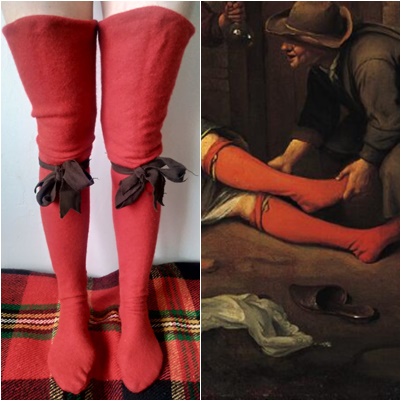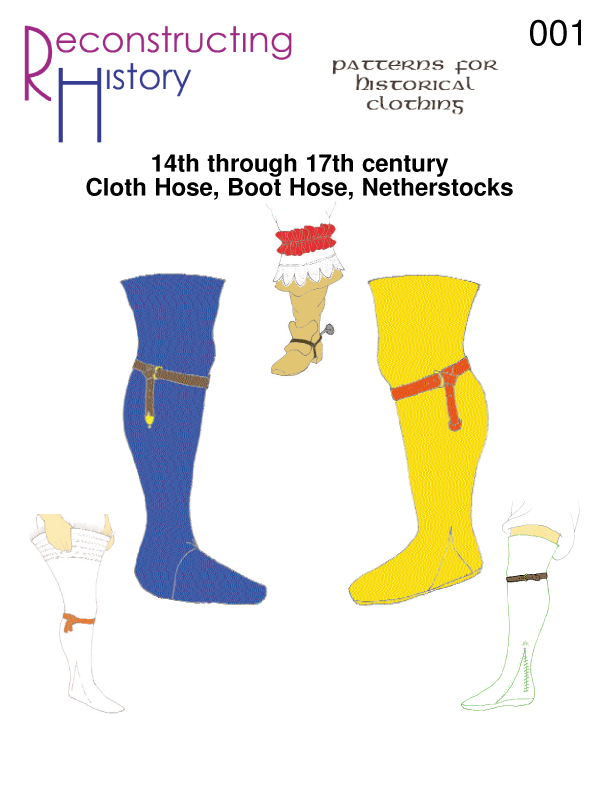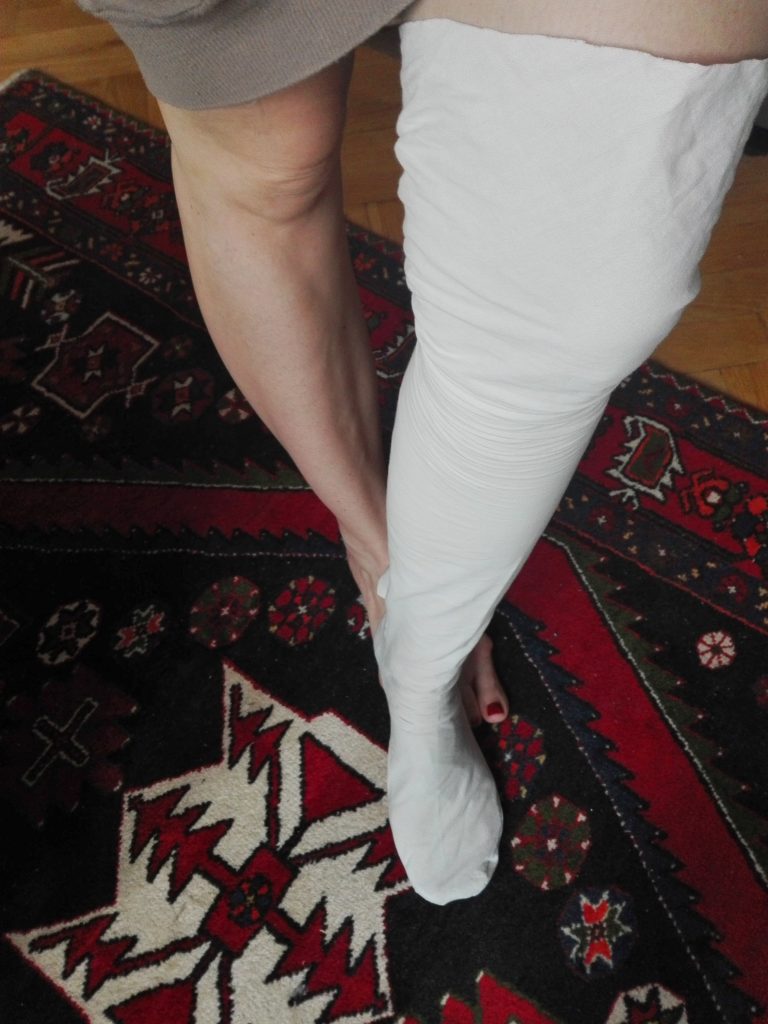
For a few years I have observed the fashion of increasing width of stockings between the reenactors. I was wondering why it is so hard to adapt this fluttering sail around the ankles to the curves of human feet. I myself admit, that since I have been interested in this hobby (since 2015) I have worn black knitted garter stockings under the skirt, which are somehow neutral and because of the relatively long skirt they are not very visible. This summer, I finally decided to sew my stockings for my "Thirty Years’ War" outfit. So not just because I needed them, but because I wanted to test how hard it is to fit stockings to the width of the legs.
What did I want to achieve?

VRANCX, Sebastian. January
Beautifully fitted stockings from Vrancx, a feast for my eyes.

DE GHEYN II, Jacques. Plate 22, in Wapenhandelinghe van Roers Musquetten Ende Spiessen (The Exercise of Arms)
Pikeman from De Gheyn. A soldier sliding his right hand along the training-pike, from the Lansquenets series, Jacques de Gheyn II.
Step by step

After my experience with the texts from Reconstructing History, I decided to buy a pattern for stockings for further study/instructions. On this website I used to download various texts on-line and a few patterns, each pattern has an accompanying text with useful advice. In my beginnings it was a great help and I know from previous experience that these texts have helped me in the construction of some costumes, which advise where and how to cut/seize and what tricks to use for your costume to fit. Most of the texts really helped more than the attached pattern.
(I even decided to buy this one and have it shipped, which turned out to be unnecessary because the shipment looks exactly like what you print at home and you pay unnecessary postage. Although the first page is colored and you don't have to stick to the pattern, you have to go to the customs post office and pay unnecessary postage. If you want to order something from Reconstructing History online version is enough.)
First of all, I decided to try to create an "ideal" pattern fitting on my leg from some old cloth. Never throw away old sheets, there are never enough of them. I remembered right from the start that a cotton sheet would never be as elastic as the wool from which I´ll make the final stocking. Even when I achieve elasticity by cutting at 45 degree angle cotton will never stretch so much. So I knew that I would definitely tighten and smooth the woolen stocking a little bit, but as an ideal pattern, cotton served well. I made a „tailor-made“stocking and I can (hopefully) use it my whole life - provided my calves or ankles do not get fat. :)




This was the result of that ideal pattern – and that was the one of the "most demanding" phases. It was the hardest because you still had to undress it, adjust, put on, undress, adjust, put on ... So it was not much about skills, but stamina. And it's also not that simple when your baby is crawling around and pulling the other end of the stocking. :)
-
I cut a stocking pattern that covers the most part of the leg from Reconstructing history + the trace of my foot + gusset - all at an angle 45 degrees .
- I sewed the back seam first and then added the gussets end at last part of the foot.
- I got a wider hose, which I seized on my leg with my hand on the back seam and sketched out new future seams with a marker. Then I narrowed the stocking and adjusted the gusset. I repeated this until the stocking fit my foot as I imagined.
- At the end - testing: The ideal hose shouldn't be sloppy, but it should not strangle either, it must not cut off your circulation, we should get into it with some difficulty, but feel good in it in all positions.
- In order for the stocking to fit perfectly and not crawl around the ankles anywhere, the decisive instructions and, in my opinion, the most important advice from the whole text from Reconstructing history were: “People with small ankles will need to cut a deeper slit and use a longer, narrower ankle gusset. Those with larger ankles will need an ankle gusset that is wider at the bottom and short in length.” These two sentences were worth all the money I gave for this pattern. It is very important to know exactly where to tighten the stocking, to know exactly what to enlarge or shrink for it to fit your ankle. I tried to tighten the stocking only on the side of the Achilles heel or at the joints at the foot or somewhere else, and nothing worked like cutting the perfect ankle gusset as described in the instructions. Since my ankles are thin enough, I had to cut out a brand new gusset that was really much narrower and longer. The more I narrowed and lengthened it, the more the stocking fit to my leg. It is not at all important to have a regular triangle, it is important to have an ideal gusset. Everyone has their own ideal gusset! Although the instructions advised to use the help of another person, since it is much easier to comfortably seize stockings, I managed to sew the stocking all by myself.

This was followed by sewing a hose from wool. I first tore my cotton pattern and cut it out of a woolen cloth at an angle of 45 degrees.


I had a dilemma about sewing technique - machine versus hand sewing. At first I wanted to have hand-stitched stockings – not just because I´m always aiming to achieve the highest historical accuracy, I also wanted to achieve the greatest elasticity, which hand sewing provides. However, it takes longer to sew a stocking by hand than with a machine, and since I knew I was going to tighten the stocking somewhere, I didn't want to rip and stitch the handmade seam. In the end I decided to compromise: I sewed stockings on the machine to the ideal shape and finally altered with a hand seam and ripped the machine seam. What surprised me was that the stocking was just right after the first stitching, without any modifications, it fitted perfectly, which perfectly confirms that a pattern from cotton can serve perfectly. However, paradoxically, during a few try-outs they started loosening a bit, so I tightened them a couple of times (so I understand that after some time they will be baggier, like all woolen costumes).
However, when altering the machine seam, I encountered an unexpected problem - hand seam, although it was a recommended historical seam according to Reconstructing history, the double linen blacksmith thread ripped. I don´t understand this hurdle - the seam ripped at the calf, not at the ankle. I tried to stitch the stocking twice with a running stitch with double linen thread and the result ripped. This point of my research will remain a mystery to me. The hand seam was supposed to provide inherent stretch and the linen thread is stronger than the cotton one from the machine, with which I firstly sewed the stocking. The only possible explanation seemed to be the problem of flexibility, which the sewing machine provides and the hand must achieve a similar effect in some other way, or I cannot explain how it is possible that the ordinary machine stitch did not rip during several tries and the double linen thread did. For the third time I tried the second recommended stitch from the manual, and that was the back stitch. In my new try (because I wanted to be sure - or maybe just for experiment sake?) after each individual stitch I stretched the fabric to be sure that with new seam I will get some stretch and then continued. I don´t really know what helped, but the back stitch stretched really great and the stocking did not break.

The question is whether to wrap the edges of the wave that I have left free. I think time will tell me if it will be needed.




I chose the worst weather for sewing. It was really hot for me to keep trying on my stocking, because that's what it's all about - trying and tightening on the leg until it's exactly what you wanted. For beautifully fitted calves, you actually only need a little patience and stamina. I really put on a very narrow stocking in 34+ degrees about 30 times on my leg.
To make matters worse, I finished the stockings in the second trimester of pregnancy, when there was no danger of swelling of the legs, but testing with the belly was no longer very comfortable. I will definitely wait a few months to wear them now, so that someone doesn't have to cut them off my feet in the afternoon swelling…
What did I use?
- Old sheet
- Any cotton thread for machine sewing
- Medium-thick red cloth from Wooltrade, 100% wool
- Red linen thread
What will I do differently next time?
- I won't sew in 34+ degrees
- I won't sew while pregnant
Highlights:
- Create an ideal ankles gusset according to the rule: narrow ankle = long narrow gusset, wider ankle = shorter wider gusset
- Do not wear your stocking during pregnancy, because you´ll never take it off :)



Když jsem šil ty své vlněné…
1. při testovacím kousku (taky z vlny) jsem použil následující steh (nevím jak se jmenuje,takže popíši) – přeložil jsem dva kusy přes sebe (ne ____//___, ale __==—) a šil jsem jakože spirálu – a neutahoval. Ukázalo se, že to byla správná volba, protože po pár nošeních, zvlhnutích a sušeních se daný šev zaplstil a přitom zůstal pružný.
2. A to je vlastně odpověď i na „Otázkou zůstává, zda zalemovat okraje třepící se vlny, které jsem zatím nechala volně. Myslím, že čas ukáže, zda to bude zapotřebí.“